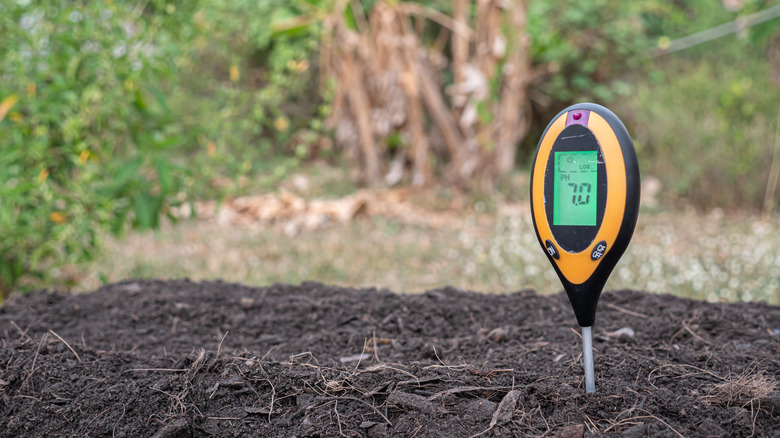For The Most Success With Blueberry Shrubs, This Is How You Should Prepare Your Soil
We may receive a commission on purchases made from links.
There's nothing quite like stepping out into your backyard to enjoy a handful of berries picked fresh from your own plant. If you're looking for a fruiting shrub that's often featured on lists of the easiest plants to grow for beginner gardeners, blueberries are the perfect place to start. Blueberries (Vaccinium spp.) are a classic among berry-producing shrubs — the various species and cultivars add color and food to home gardens around the country. With their pretty spring flowers, abundant summer fruit, and eye-catching fall foliage, blueberries are a year-round statement plant. However, in order to see success when growing blueberry shrubs, you need to take some time to prepare the soil in which the shrub will grow. In short, you need to test the soil's pH levels and, if they're alkaline, add sulfur.
The pH value of soil tells you whether it's more acidic, like lemon juice or vinegar, or more alkaline, like ammonia or baking soda. Neither value is inherently better than the other; instead, some species of plant grow best in soil with a specific pH value. Blueberries prefer a more acidic growing medium. The exact pH level can vary based on which species of blueberry you're growing, but in most cases, a pH value somewhere between 4.8 and 5.3 works best. If your soil isn't at the level you need it to be, don't fret. There are ways to make your soil more acidic for a healthy garden — and happy blueberry bushes full of bright foliage and juicy fruit.
How to create soil for blueberries with optimal pH levels
To create soil with a pH tailored to blueberries, you'll need to get started as early as four months before planting your bushes. Before adding any pH-lowering amendments to your soil, you need to measure the pH of your soil with a tester, like the Terru 6-in-1 Soil Test Kit for Gardening. After all, you won't need to drop your soil pH if it's already at the right level. If it is where it should be, you'll still need to test periodically in the months or weeks leading up to planting your blueberries — and while they're growing — to make sure everything stays the same. If the tester readings come high (that is, alkaline) and you need to alter the soil pH levels, you really have only one option.
Sulfur is the most widely used additive for lowering pH levels when planting blueberries, and it's your best option. It comes as a powder, like Gardenwise 90% Purity Wettable Sulfur Powder, or granules, like Lancaster Agricultural Products 90% Organic Elemental Sulfur Fertilizer. The amount you apply to your soil varies considerably depending on the purity of the product, what type of soil you have, and how much you need to lower the soil pH. It's best to consult the manufacturer's instructions for ratios. In a pinch, two tablespoons of vinegar diluted in one gallon of water may temporarily acidify soil, but the effects don't last long. Though often recommended, coffee grounds aren't reliably acidic, so are best avoided. Canadian peat moss can lower soil pH values, but it may not be worth the hassle. It's expensive, a non-renewable resource, and should be used alongside sulfur anyway.

